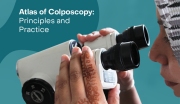Home / Training / Manuals / Colposcopy and treatment of cervical intraepithelial neoplasia: a beginnersí manual / Appendix / Appendix 5: The modified Reid colposcopic index (RCI)*
* Colposcopic grading performed with 5% aqueous acetic acid and Lugol's iodine solution. (See Appendix 3 for recipes for 5% acetic acid and for Lugol's iodine solution).
1 Microexophytic surface contour indicative of colposcopically overt cancer is not included in this scheme.
2 Epithelial edges tend to detach from underlying stroma and curl back on themselves. Note: Prominent low-grade lesions often are overinterpreted, while subtle avascular patches of HSIL can easily be overlooked.
3 Score zero even if part of the peripheral margin does have a straight course.
4 At times, mosaic patterns containing central vessels are characteristic of low-grade histological abnormalities. These low-grade-lesion capillary patterns can be quite pronounced. Until the physician can differentiate fine vascular patterns from coarse, overdiagnosis is the rule.
5 Branching atypical vessels indicative of colposcopically overt cancer are not included in this scheme.
6 Generally, the more microcondylomatous the lesion, the lower the score. However, cancer also can present as a condyloma, although this is a rare occurrence.
7 Parakeratosis: a superficial zone of cornified cells with retained nuclei.
Colposcopic prediction of histologic diagnosis using the Reid Colposcopic Index (RCI)
Colposcopy and treatment of cervical intraepithelial neoplasia: a beginnersí manual, Edited by J.W. Sellors and R. Sankaranarayanan
Appendix 5: The modified Reid colposcopic index (RCI)*
Filter by language: English / FranÁais / EspaŮol / Portugues / 中文| Colposcopic signs | Zero point | One point | Two points |
| Colour | Low-intensity acetowhitening (not completely opaque); indistinct acetowhitening; transparent or translucent acetowhitening Acetowhitening beyond the margin of the transformation zonePure snow-white colour with intense surface shine | Intermediate shade - grey/white colour and shiny surface (most lesions should be scored in this category) | Dull, opaque, oyster white; grey |
| Lesion margin and surface configuration | Microcondylomatous or micropapillary contour1 Flat lesions with indistinct marginsFeathered or finely scalloped margins Angular, jagged lesions3 Satellite lesions beyond the margin of the transformation zone |
Regular-shaped, symmetrical lesions with smooth, straight outlines | Rolled, peeling edges2 Internal demarcations between areas of differing colposcopic appearance-a central area of high-grade change and peripheral area of low-grade change |
| Vessels | Fine/uniform-calibre vessels4- closely and uniformly placed Poorly formed patterns of fine punctation and/or mosaic Vessels beyond the margin of the transformation zone Fine vessels within microcondylomatous or micropapillary lesions6 |
Absent vessels | Well defined coarse punctation or mosaic, sharply demarcated5 - and randomly and widely placed |
| Iodine staining | Positive iodine uptake giving mahogany-brown color Negative uptake of insignificant lesion, i.e., yellow staining by a lesion scoring three points or less on the first three criteria Areas beyond the margin of the transformation zone, conspicuous on colposcopy, evident as iodine-negative areas (such areas are frequently due to parakeratosis)7 |
Partial iodine uptake - variegated, speckled appearance | Negative iodine uptake of significant lesion, i.e., yellow staining by a lesion already scoring four points or more on the first three criteria |
* Colposcopic grading performed with 5% aqueous acetic acid and Lugol's iodine solution. (See Appendix 3 for recipes for 5% acetic acid and for Lugol's iodine solution).
1 Microexophytic surface contour indicative of colposcopically overt cancer is not included in this scheme.
2 Epithelial edges tend to detach from underlying stroma and curl back on themselves. Note: Prominent low-grade lesions often are overinterpreted, while subtle avascular patches of HSIL can easily be overlooked.
3 Score zero even if part of the peripheral margin does have a straight course.
4 At times, mosaic patterns containing central vessels are characteristic of low-grade histological abnormalities. These low-grade-lesion capillary patterns can be quite pronounced. Until the physician can differentiate fine vascular patterns from coarse, overdiagnosis is the rule.
5 Branching atypical vessels indicative of colposcopically overt cancer are not included in this scheme.
6 Generally, the more microcondylomatous the lesion, the lower the score. However, cancer also can present as a condyloma, although this is a rare occurrence.
7 Parakeratosis: a superficial zone of cornified cells with retained nuclei.
Colposcopic prediction of histologic diagnosis using the Reid Colposcopic Index (RCI)
| RCI (overall score) | Histology |
| 0 - 2 | Likely to be CIN 1 |
| 3 - 4 | Overlapping lesion: likely to be CIN 1 or CIN 2 |
| 5 - 8 | Likely to be CIN 2-3 |





